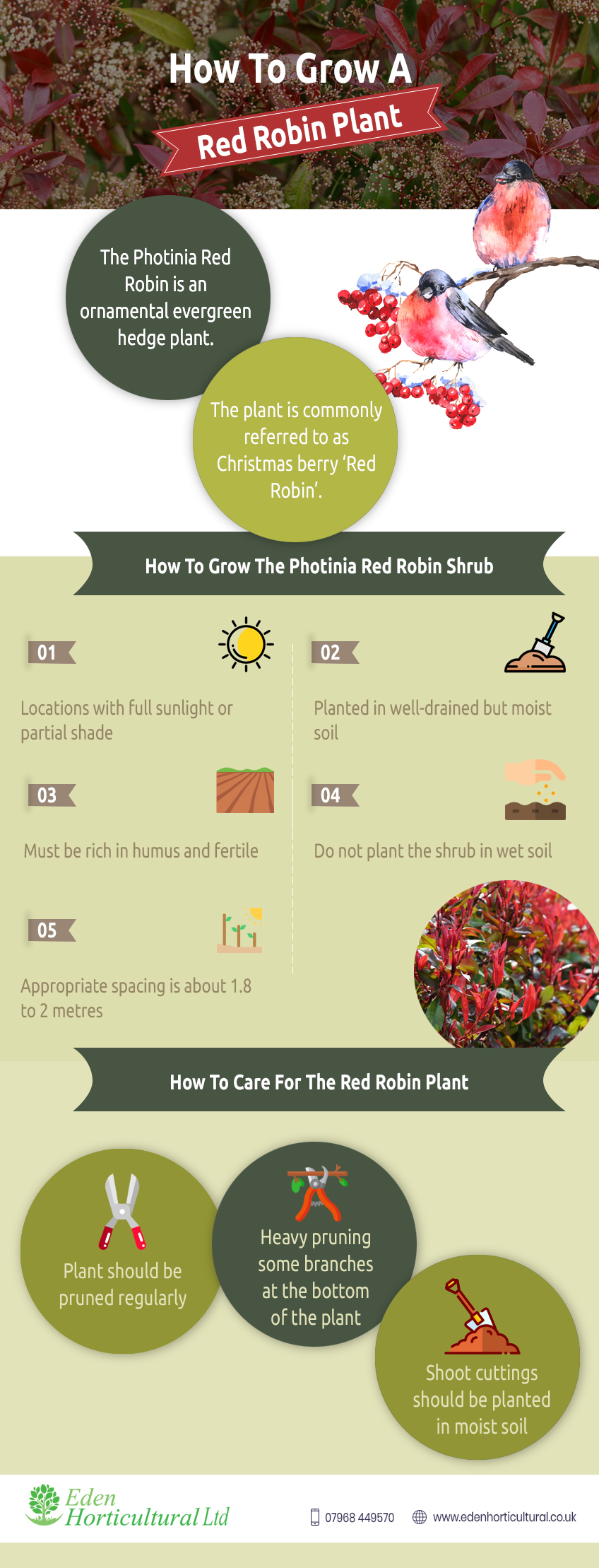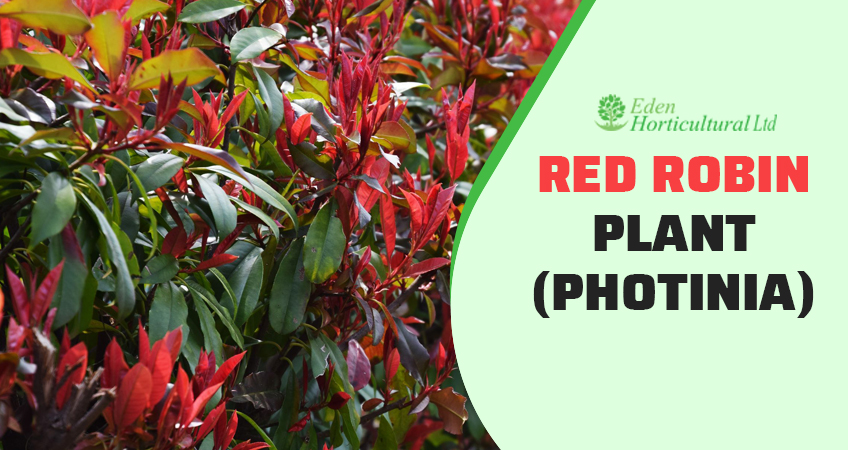The Photinia Red Robin is an ornamental evergreen hedge plant that grows in the eastern part of the US. Its name is derived from its young, glossy, red leaves which change to dark green as they mature. These leaves grow up to 10cm in length.
The shrub is commonly used as a hedge plant because of its stunning colour transition. It also produces beautiful, white flowers in spring, so long as the plant was not previously pruned. Red Robin is not only used for hedges, but it could also be used for screens, or shaped into a specimen tree.
The plant is commonly referred to as Christmas berry ‘Red Robin’.
General Description Of The Plant
This hedge plant is quite dense and medium-sized in appearance. A fully grown red robin tree can easily be managed to 4 feet in height with regular maintenance However, when it is used as a specimen tree, it can become as high as 6 metres. It takes the plant about 10 to 20 years to reach its full height. Its full-spread ranges from 2.5 to 4 metres. Its full-spread ranges from 2.5 to 4 metres. The leaves of this shrub are its most unique features. When a new leaf unfurls, it has a bright, glossy red colour, but as it matures, it gradually changes into dark green. Pruning the tips of the shoots keeps the plant stimulated to produce new leaves annually.
The plant also produces sparse, creamy-white flowers, which give way to the leaves. Some people find these flowers quite unpleasant and cannot stand their smell.
Botanical Description Of The Plant
Photinia red robin is a hybrid plant and is a cross between the Chinese photinia, Photinia serrulata, and the Japanese photinia, Photinia glabra. The latter is a small plant whose leaves undergo the beautiful colour transition while the former is a large, sprawling plant. The hybrid name of this plant is Photinia x fraseri. This name was derived from the fact that the plant was initially identified by Fraser’s Nursery, of Birmingham, Alabama. So, this plant is sometimes referred to as Fraser’s Photinia.
The red robin plant belongs to the Rosaceae family, and Genus Photinia.
Characteristics Of The Plant
This shrub thrives in sunny weather and can tolerate periods of drought. It can also tolerate some shade, but when the shade is quite dense, it makes the plant more susceptible to diseases. In cold climates, the plant thrives in the full sun. However, in hotter climates, it thrives under partial shade and is at it’s best when it is planted facing the north or east.
The foliage of the red robin plant is evergreen, and its habit is bushy. The plant is hardy in most places in the UK, even in severe winter.
How To Grow The Photinia Red Robin Shrub

It grows best in locations with full sunlight or partial shade. It should be planted in well-drained but moist soil. The soil type could be sandy, clay, or loamy, with its pH ranging from 1 to 7. Regardless of which soil type you use, it must be rich in humus and fertile. If you are using heavy clay soil, ensure that half of it is made up of compost. Also, do not plant the shrub in wet soil as it could lead to the rotting of the roots.
Photinia red robin can be planted for hedges or screens. If you want to use it as a hedge plant, ensure that the plants are well-spaced because of its full spread. The appropriate spacing is about 1.8 to 2 metres.
How To Care For The Red Robin Plant
The ends of the shoot should be pruned frequently to ensure that it keeps on producing its bright red leaves. Another reason why the plant should be pruned regularly is that its flowers smell unpleasant to some people. Heavy pruning some branches at the bottom of the plant periodically would help to improve airflow. Thus, it would also make the plant less susceptible to some fungal diseases.
A pest to look out for is the vine weevil which eats the red robin leaves. A disease that could affect the plant is fireblight. It is also susceptible to fungal diseases when the weather condition is wet or humid. The plant could also have leaf spots and powdery mildew.
The propagation of this plant is through woody cuttings because of its hybrid nature. Shoot cuttings should be planted in moist soil in pots to help them grow quickly.
In Conclusion
There is no denying that the red robin plant would make your house more attractive. A primary benefit of this plant is that it requires low maintenance, so you wouldn’t have to undergo a lot of stress to keep it thriving.



